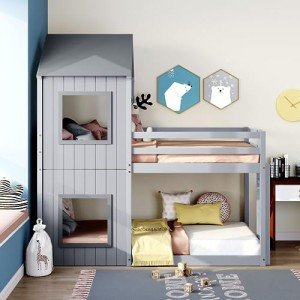10 Facts About Bunk Bed That Can Instantly Put You In A Good Mood

A Comprehensive Guide to Children's Bunk Beds: Styles, Benefits, and Safety Considerations
Bunk beds have ended up being a popular option for households aiming to make the most of space and supply a fun sleeping environment for kids. With their unique design, they provide an imaginative and practical service for shared bedrooms, playrooms, or perhaps guest accommodation. This short article checks out the different designs of children's bunk beds, their benefits, security factors to consider, and answers some often asked questions.
The Allure of Bunk Beds
Children's bunk beds are more than just space-saving structures; they are likewise an entrance to adventurous dreams and imaginative play. Below is an in-depth assessment of their various benefits.
Benefits of Bunk Beds
- Space-Saving: Bunk beds effectively make use of vertical space, making them an ideal option for smaller sized rooms.
- Lively Design: Many bunk bed styles consist of slides, camping tents, and themed components, sparking creativity and enjoyment.
- Partner Sharing: Bunk beds are ideal for siblings sharing a space or accommodating pajama parties.
- Versatile Use: Some models can be separated into two private beds, using versatility as kids grow.
- Storage Options: Many bunk beds come with integrated drawer storage or racks, even more enhancing their functionality.
Styles of Children's Bunk Beds
The variety of bunk beds readily available today accommodates various preferences and needs. Below is an introduction of some popular styles.
| Design | Description | Best For |
|---|---|---|
| Standard Bunk Bed | A traditional style including one bed stacked above another. | Siblings sharing a room. |
| Loft Bed | Similar to a bunk bed without the bottom bunk, permits for an office or play location below. | Minimal space for play/desk. |
| L-Shaped Bunk Bed | Two beds organized in an L-shape, often with extra areas for storage or play. | Distinct space designs. |
| Twin Over Full | A twin bed over a complete bed, accommodating various sleep requirements. | Growing children and teens. |
| High Sleeper | Stands even higher than a loft bed, usually including a desk or play area below. | Older kids requiring more play/desk space. |
| Tent Bunk Bed | Bunk beds with a canopy or tent-like structure, creating a comfortable, fun space. | Active and imaginative kids. |
Key Features to Consider
When picking the ideal bunk bed for kids, the following functions are worth considering:
- Material: Bunk beds can be made from wood, metal, or a mix. Each has its distinct aesthetic and toughness.
- Weight Capacity: Always validate the weight limit of the bunk bed to ensure it can accommodate your kids securely.
- Security Rails: Ensure the top bunk has strong rails to avoid falls.
- Ladder Security: A well-designed ladder should use simple and safe access to the upper bunk.
- Completing: Ensure any finishes are non-toxic and safe for kids.
Security Considerations
Security is vital when it pertains to kids's bunk beds. The following standards ought to be stuck to:
- Age Appropriateness: Generally, kids under six years of ages ought to not oversleep the upper bunk due to safety dangers.
- Strong Construction: Ensure the frame and products are strong and can support the weight without sagging.
- Routine Maintenance: Periodically inspect for loose screws, bolts, or other parts that may require tightening up.
- Clear Play Area: Keep the area around the bunk bed devoid of toys and barriers to decrease tripping threats.
Setting Rules for Safe Use
Developing standards for bunk bed usage will assist guarantee security:
- Limit Jumping and Climbing: Children must be encouraged versus leaping from the top bunk and getting on the sides.
- Supervising Sleepovers: Monitor young guests while they are utilizing the bunk bed for the very first time.
- Educate on Ladder Use: Teach how to utilize the ladder safely, stressing the significance of dealing with the ladder when climbing up or down.
Often Asked Questions
1. What click the up coming web page is suitable for a kid to sleep in the top bunk?
A lot of makers recommend that children should be at least six years of ages to oversleep the upper bunk. This guideline is created to mitigate the risk of falls.
2. Can bunk beds be customized?
Yes, lots of makers offer customizable choices, including colors, materials, and additional features like drawers or desks.
3. Are bunk beds safe for weight?
Bunk beds have weight limits, usually ranging from 200 to 400 pounds, depending upon the model and material. Always check the maker's specs.
4. How do I keep and clean up a bunk bed?
Frequently inspect for loose parts, keep the bed tidy by cleaning down surfaces, and ensure the bed linen is fresh to promote a safe and sanitary sleep environment.
5. Can bunk beds be separated into private beds?
Numerous bunk beds come with an alternative to separate them into 2 specific beds, supplying long-term flexibility.
Kid's bunk beds are more than simple furniture; they are a practical, versatile, and creative part of a child's space. With different designs available and numerous safety considerations to bear in mind, moms and dads can select the best bed that fits their space, satisfies their children's requirements, and instills a sense of adventure. By understanding the advantages, styles, and precaution associated with bunk beds, families can develop a wonderful and safe and secure sleeping environment for their kids. Whether for brother or sisters sharing a space or space-saving options, bunk beds stay a beloved option for lots of homes.

